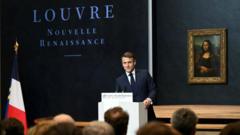As part of an ambitious renovation initiative termed the New Renaissance project, French President Emmanuel Macron has announced that the Mona Lisa, Leonardo da Vinci’s masterpiece, will be relocated within the Louvre Museum in Paris. This significant move is a response to ongoing overcrowding issues and aims to provide better viewing experiences for visitors.
Louvre to Relocate Iconic Mona Lisa Amid Major Museum Renovation

Louvre to Relocate Iconic Mona Lisa Amid Major Museum Renovation
President Macron reveals plans for Louvre's transformation, including a new home for the Mona Lisa and steps to address overcrowding.
The relocation of the Mona Lisa, set to be completed by 2031, comes alongside other major changes intended to improve visitor access to the museum. Macron made the announcement in front of invited dignitaries while addressing the increasing challenges presented by the Louvre's current layout, famously noted to attract around 30,000 visitors each day. According to museum director Laurence des Cars, these staggering visitor numbers have exposed severe infrastructure inadequacies.
The Louvre's Pyramid entrance, a landmark designed by architect I.M. Pei over three decades ago, is under scrutiny for its inability to handle the annual influx of over nine million visitors. In a recent correspondence, des Cars emphasized that the presentation of the Mona Lisa, often seen by countless eager eyes in a crowded setting, warrants a reevaluation to enhance the public’s understanding of the artwork.
Under Macron's New Renaissance plan, the museum's eastern facade is slated for redesign, which will include a new entrance leading directly to upcoming underground exhibition spaces. This renovation aims not only to ease congestion but to return a sense of accessibility to Parisians. The new design, a departure from tradition, would feature green zones to harmonize with city aesthetics, thereby integrating the Louvre into the urban landscape.
Furthermore, the redistribution of ticket pricing from January will result in higher fees for non-EU residents, contributing to a revitalization effort projected to cost hundreds of millions of euros. Macron has reassured that taxpayer money will not be utilized in this scheme, as funding will derive from ticket proceeds, charitable donations, and partnerships, such as the sponsorship agreement with the Louvre Abu Dhabi.
This endeavor marks a pivotal moment for Macron's leadership, as he seeks to solidify his legacy following a setback in parliamentary control. With his recent success in revitalizing Notre-Dame cathedral, the President is poised to apply his vision to the Louvre, ensuring that this historic landmark evolves to meet the modern needs of its global audience.
The Louvre's Pyramid entrance, a landmark designed by architect I.M. Pei over three decades ago, is under scrutiny for its inability to handle the annual influx of over nine million visitors. In a recent correspondence, des Cars emphasized that the presentation of the Mona Lisa, often seen by countless eager eyes in a crowded setting, warrants a reevaluation to enhance the public’s understanding of the artwork.
Under Macron's New Renaissance plan, the museum's eastern facade is slated for redesign, which will include a new entrance leading directly to upcoming underground exhibition spaces. This renovation aims not only to ease congestion but to return a sense of accessibility to Parisians. The new design, a departure from tradition, would feature green zones to harmonize with city aesthetics, thereby integrating the Louvre into the urban landscape.
Furthermore, the redistribution of ticket pricing from January will result in higher fees for non-EU residents, contributing to a revitalization effort projected to cost hundreds of millions of euros. Macron has reassured that taxpayer money will not be utilized in this scheme, as funding will derive from ticket proceeds, charitable donations, and partnerships, such as the sponsorship agreement with the Louvre Abu Dhabi.
This endeavor marks a pivotal moment for Macron's leadership, as he seeks to solidify his legacy following a setback in parliamentary control. With his recent success in revitalizing Notre-Dame cathedral, the President is poised to apply his vision to the Louvre, ensuring that this historic landmark evolves to meet the modern needs of its global audience.






















